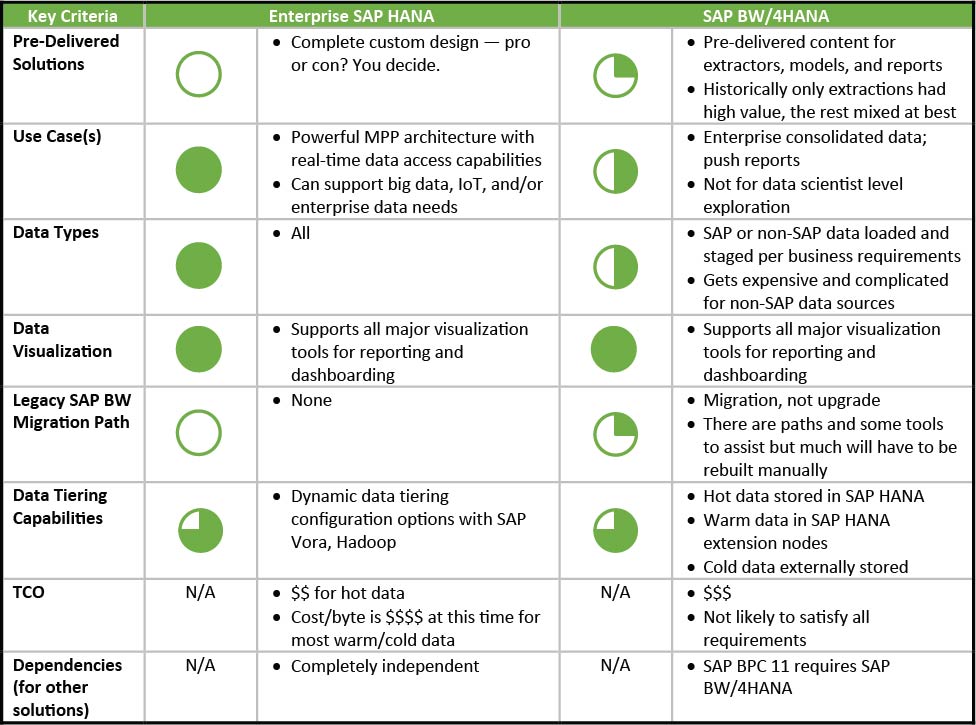The Many Faces of the Future of SAP Analytics – Part 2 (Do You Still Need, or Want, an Enterprise Data Warehouse?)
As promised in my last post, I’d like to continue the conversation about the future of SAP analytics in its many forms. In Part 1, I introduced this series of discussions with a trip in the Way Back Machine to look at the early days of SAP analytics solutions (LIS, HRIS, SIS, etc.) and the impact the introduction of SAP Business Warehouse (SAP BW) had on how we designed and delivered analytics in an SAP environment.
A lot has happened since those early days, and this topic has been of interest to me (and my former clients) for quite a while. Here in Part 2, I’ll look at how changes in thought process, user requirements, and technologies have affected the way we think about enterprise data warehouses (EDWs) — and whether we still need them.
The Legacy of EDWs
The vast majority of EDWs in SAP landscapes today should be considered “legacy” data warehouses. While these legacy data warehouses were built with good intentions and with the most advanced designs of the time, technologies and needs have changed, and what made sense then no longer meets current goals, meaning that it’s time to plan for their retirement.
The primary objective of the EDWs of the 1990s and 2000s was a single view of the truth (SVOT). But was the SVOT goal ever realistic? No, not really. Why not? A few reasons:
-
- Batch loading meant latency in the data (and therefore gaps in data)
-
- Data models forced pre-aggregation and defined data relationships (therefore limiting creativity and new ways of looking at data)
-
- There was no way to access raw data and create new relationships or models on demand
- Do we really all have the same “view”? If so, then why do we have so many reports and types of analyses?
Should we instead aim for a single version of the truth? Again, I challenge that thought. There is only one truth; not alternative versions of the truth.
With that in mind, let’s look at data warehouses under a slightly different lens: as a single source of the truth. This makes us look at the EDW as an environment in which trusted data resides and which becomes the platform for all reports and analysis. It encourages us to view the data in multiple ways to uncover the true answer to different questions.
Another goal of legacy EDWs was to push pre-aggregated data and reports to consumers of information. Because of technical constraints, we had (or allowed) limited ability to create new data models and therefore could not form or drive out new data relationships to align with our dynamic business environments. All of this limited the user community for our EDW and restricted them to being used by mostly casual consumers of information or those who subscribed to reports generated from the warehouse. Today’s users demand more flexibility and more than casual consumption of data.
The Future of EDWs
Looking at the goals and objectives as well as the constraints and challenges of the EDWs of the past, how do we move forward with them? Should we move forward them? In my opinion, yes, there is a place for EDWs today and tomorrow in your overall enterprise information architecture or analytics strategy.
Why do I feel that EDWs continue to make sense? An EDW will:
-
- Be a source of enterprise-relevant information from multiple transaction systems and external sources (as appropriate or required) — not just data from a single transaction system
-
- Be a collection of time-variant enterprise-relevant data from multiple sources (necessary for meaningful time-based trend analyses)
-
- Be pre-aggregated and pre-integrated into business-aligned groupings and structures
- Address the 80% of the user base who want/need to subscribe and have information pushed to them in the form of reports, dashboards, and alerts
Modern data warehousing designs need to address these requirements and include unstructured data, address real-time access, and provide scalability and flexibility — things our legacy data warehouses simply could not deliver. SAP offers two solutions for addressing today’s data warehousing needs: SAP BW/4HANA and enterprise SAP HANA (also known as SAP HANA “sidecar”).
There are pros and cons for both SAP BW/4HANA and enterprise SAP HANA. Much like legacy SAP BW, SAP BW/4HANA offers pre-defined content and connectivity to the SAP transaction system, SAP S/4HANA. Using enterprise SAP HANA as a data warehouse offers the most flexibility, as it is a “build from scratch” approach, but not every organization wants or needs to build from scratch.
When looking at both SAP BW/4HANA and enterprise SAP HANA for your data warehousing needs, assess it against the criteria that are most important to you. Here is an example assessment that I created recently for a very similar discussion that might be helpful as you prepare your own analysis:

Key Takeaways
To close out the discussion for this week, here are a few takeaways for you to noodle on:
-
- Enterprise-relevant information is — and always will be — a need for your organization
- A data warehouse (or EDW) still serves a key role in your overall enterprise analytics framework because it:
- Brings together data from multiple sources
- Provides time-variance to data
- Organizes data into models optimized for users
- A data warehouse is not a data lake (which will be next week’s discussion) because a data lake:
- Is raw data
- Is all data, not just data known to have enterprise relevance
- And finally, as with our previous discussions, there are multiple tools and options to meet data warehousing requirements. Assess each of them against your key criteria to determine the best option for your organization.
Thank you for joining me on this journey to the future and please do not hesitate to reach out with your comments, feedback, and questions via email (penny.silvia@wispubs.com) or Twitter (@pennysilvia).








